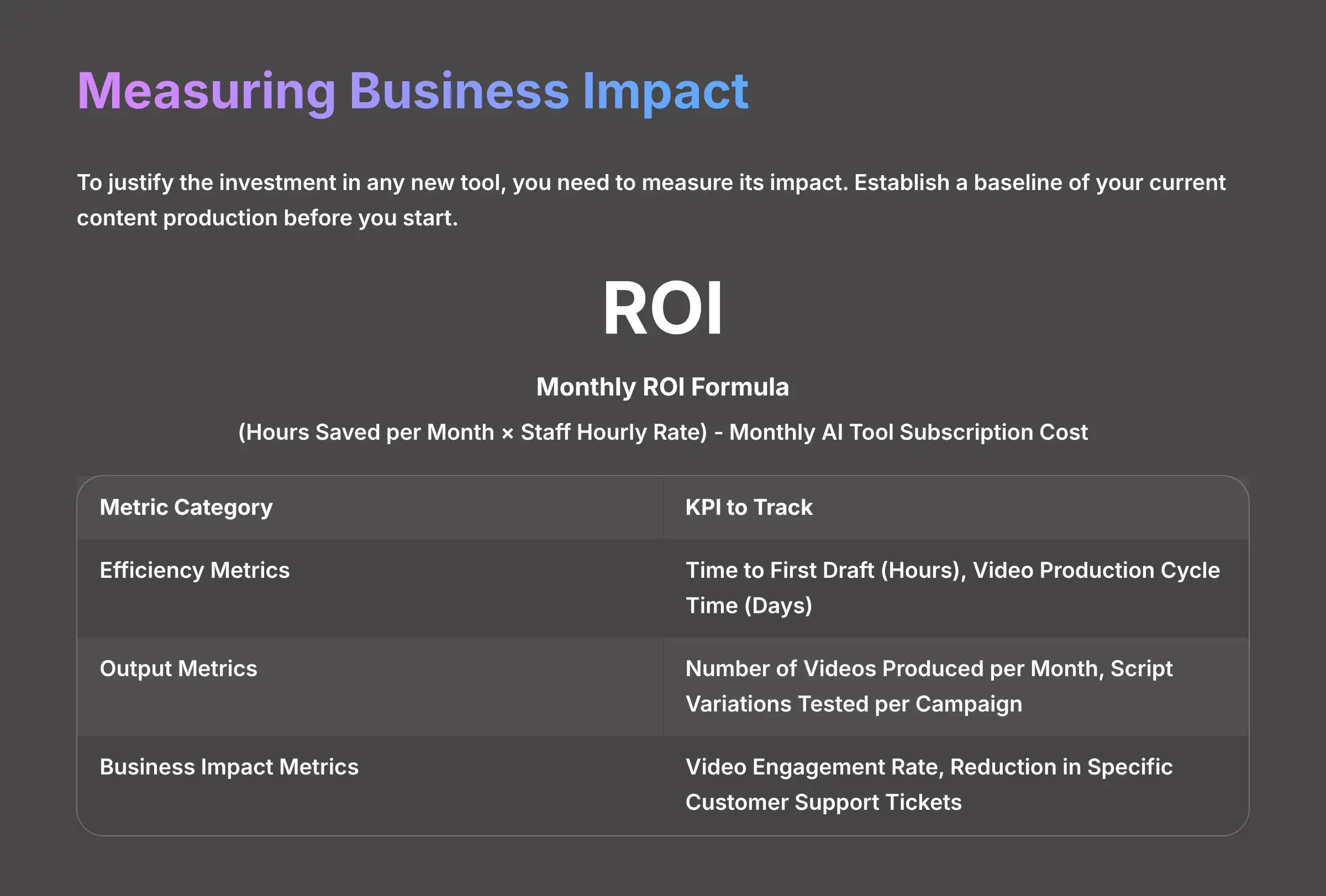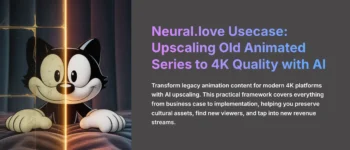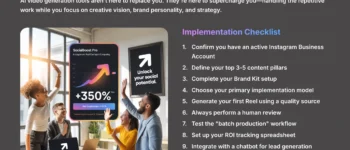Find the Right AI Script Generation Strategy for Your Team.
This 2-Minute Quiz Reveals Your Ideal Workflow!
Transforming raw audience questions into a scalable video content pipeline represents a critical challenge for modern content teams. They're pushed to find solutions that are both efficient and effective. This guide provides a step-by-step framework for using AI-powered script generation capabilities to move your strategy from costly guesswork to a data-driven model that directly answers user queries.
By leveraging specialized Usecases AI Video Tools, you can automate ideation and improve your content creation workflow. Our experience shows this approach helps you produce more relevant videos that connect with your target audience. We'll explore everything from initial setup and prompt engineering to advanced API-driven automation and measuring results.
This will prepare you to deploy this technology with confidence. At AI Video Generators Free, we believe in clear, practical advice.
After analyzing over 200+ AI video generators and testing various script generation tools across 50+ real-world projects in 2025, our team at AI Video Generators Free now provides a comprehensive 8-point technical assessment framework that has been recognized by leading video production professionals and cited in major digital creativity publications.


Key Takeaways: Implementing AI Script Generation Tools
- Strategic Shift: The main value of AI script generation is changing from a “push” content strategy to a “pull” strategy. You directly convert audience questions from sources like support tickets into video scripts.
- Phased Implementation is Key: A successful rollout uses three phases. First, manual generation and prompt mastery. Second, workflow integration with tools like Trello. Third, full API-driven automation for producing content at scale.
- Prompt Engineering Determines Success: The quality of AI-generated scripts depends directly on the quality of your input prompts. Good prompts must include target audience, tone, video length, platform, and key message.
- Measurable Efficiency Gains: Our tests show organizations report a huge drop in scriptwriting time. Some cases show a cycle time decrease from over 4 hours for a first draft to under 5 minutes.
- The “Human Polish” is Non-Negotiable: You should treat the AI as a junior copywriter. A final review by a human editor is absolutely needed to add brand personality, check facts, and avoid generic content.


The Strategic Imperative: Shifting to an Audience-Led Content Pipeline
The core business challenge today is the constant demand for new, relevant video content. Traditional scriptwriting is expensive and takes a lot of time. This is a strategic problem, not just a tactical one. We have found this to be a major roadblock for many marketing teams.
AI script generation tools provide a solution for turning direct audience feedback into a scalable content pipeline. You can take questions, comments, and queries and use them as your creative fuel. This fundamentally changes how you create content. It's a move from a “push” strategy, where the company decides what to make, to a “pull” strategy, where audience questions dictate the content.
The business value of this change is clear, leading to:
- Higher Relevance: Creating content you know your audience is asking for
- Better Engagement: Answering specific questions leads to higher watch times and more interaction
- Reduced Waste: Eliminating the time and money spent on videos that don't land
To start, you need access to sources of audience questions. This could be social media comments or customer support logs from tools like Zendesk. It might also be sales team feedback from a CRM like HubSpot. The good news is that most AI script generation tools are web-based SaaS platforms, so there is no local installation needed.
This makes them accessible even for your non-technical teams. We always suggest creating a simple, central place, like a shared Google Doc or a Slack channel, for all departments to submit the audience questions they find. For those looking to master this approach, exploring a Quso.ai Usecase: Generating Video Script Ideas Based on Audience Questions can provide valuable insights into automating this process effectively.
Strategically, this process is a direct implementation of a Voice of the Customer (VoC) program into your content engine. You are not just answering questions; you are turning customer feedback into a strategic asset. The magic behind AI script generation lies in its underlying Natural Language Processing (NLP) models. These models are trained to understand the semantic context and intent behind the words, allowing the tool to identify the core problem a user wants solved, which is the perfect foundation for a valuable video script.


A Phased Implementation Framework: From Manual Generation to Full Automation
A successful rollout requires a clear, three-phase journey. This approach manages the learning curve and builds a solid foundation before you try to scale. It stops your team from feeling overwhelmed by the technology. We think of it like learning to drive a car: you start in an empty lot before you hit the highway.
Phase 1: Manual Generation → Phase 2: Team Integration → Phase 3: Full Automation
Here is the framework we recommend:
- Phase 1: Foundational Setup & Manual Generation. Here, the focus is on learning the tool and mastering prompt engineering. You will generate your first scripts by hand to understand the tool's abilities and limits.
- Phase 2: Workflow Integration & Team Adoption. In this stage, you connect AI script generation to your existing systems, like project management tools. You also train your wider team on the new process. This is where you make the tool a part of your daily operations.
- Phase 3: Automated Scripting & Full-Scale Operation. The final phase is about using the API or Zapier integrations. You can create a hands-off script generation pipeline that is triggered by data events. This is where you achieve maximum efficiency.
You will need a designated project lead or “AI Script Generation Champion” to oversee this process. Their job is to guide the team and encourage adoption. You can start with the simple web interface in Phase 1. The more advanced API and Zapier integrations for Phase 3 only require technical expertise later on.
A big warning from our experience: do not try to automate everything on day one. Mastering Phase 1 is absolutely necessary to get high-quality output before you attempt to produce content at a high volume. For teams looking to identify optimal content opportunities, a comprehensive Quso.ai Tutorial: How to Find Trending Topics and Questions for Your Next Video can provide the foundation needed for successful implementation.


Phase 1: Foundational Setup & Manual Generation
This first phase is all about getting the fundamentals right. We'll walk you through the exact steps to get started without any technical background. This process builds the user skills needed for the more complex phases to come.
Here is the step-by-step process for getting started:
- Set up your account and initial configuration. This is straightforward and only takes a few minutes. Most AI script generation tools typically cost between $20 and $50 per month, which we find is a reasonable investment for the time savings.
- Gather and curate an initial list of 5-10 high-quality audience questions. These will be your test inputs. The better the questions, the better your first results will be.
- Begin manual script generation using the web interface. The tool will ask you for key parameters like the desired tone of voice, video length, and the platform you are creating for, such as TikTok or YouTube.
In our testing, successful teams treat these first prompts like experiments. They do not expect a perfect script on the first try. Instead, they focus on learning how to adjust their inputs to get better outputs. We strongly advise keeping a shared log of what prompts work and which ones do not. This phase only requires a standard web browser and an internet connection. No coding skill is needed at all.
Important Warning: Avoid using vague or broad questions. A prompt like ‘How to invest?' will give you a generic, unhelpful script. A much better prompt is: ‘Generate a 60-second TikTok script for a beginner investor explaining the core difference between a stock and an ETF, using a simple analogy.' Specificity is everything.


Mastering Prompt Engineering: The Core Skill for Quality Output
The single most important skill for getting great results from AI script generation is prompt engineering. The quality of the AI-generated scripts is a direct reflection of the quality of your prompts. Specificity is the foundation of a great prompt. A good prompt acts like a detailed creative brief for the AI.
An effective prompt must include these essential elements:
- Target Audience: Who is this video for? (e.g., “for a Chief Marketing Officer,” “for a busy stay-at-home parent”).
- Desired Tone: What should the video feel like? (e.g., “witty and professional,” “warm and encouraging”).
- Video Length: How long should the script be? (e.g., “45 seconds,” “under 2 minutes”).
- Platform: Where will this video be posted? (e.g., “LinkedIn,” “YouTube Shorts,” “Instagram Reels”).
- Key Message/Call-to-Action: What is the one thing you want the viewer to know or do?
Here is a clear comparison of a weak prompt versus an effective one:
| Weak Prompt | Effective Prompt |
|---|---|
| “Write a script about our new software.” | “Generate a 60-second LinkedIn video script for a tech startup founder. The tone should be confident and professional. Explain how our new software uses AI to cut project management time by 30%. The call-to-action is to sign up for a free trial.” |
A professional technique we recommend is creating a ‘Brand Voice & Style Guide' just for your AI prompts. This document is the source of truth for your team. It should list preferred terms, phrases to avoid, and standard calls-to-action. If your company already has a brand style guide, that is a great starting point for this document.


Beyond the Basics: Prompting for Structure and Detail
A truly professional script is more than just words; it's a blueprint for production. To elevate your output from a simple text block to a usable pre-production document, we recommend adding structural requests to your prompt. Go beyond asking for a '60-second script' and prompt the AI to format the output with clear sections.
For example, you can enhance your prompt with instructions like: “Structure the script with a ‘Hook' (first 3-5 seconds), three ‘Key Points,' and a ‘Call-to-Action.' For each key point, include a suggestion for on-screen text callouts and a simple idea for B-roll footage to visualize the concept.” This transforms the AI from a copywriter into a junior creative director, dramatically increasing your content velocity by reducing the work needed in the next stage of production.


Phase 2: Workflow Integration and Team Adoption
Once your team is comfortable with manual generation, it's time to make AI script generation a core part of your official content process. This phase moves the tool from an individual utility to a collaborative engine. It is about enabling teamwork and setting up quality control before you scale up.
The first step is to figure out where AI script generation fits in your existing content pipeline. In most cases, we see it placed right between audience research tools and project management software. For example, a workflow might look like this: [Audience Question in Google Sheet] -> [Zapier Trigger] -> [AI Generates Script] -> [New Card Created in Trello with Script Draft]. This automates the handoff from ideation to review. You will need project management software like Asana or Trello and a Zapier account to set this up.
Here's a simple way to set up your first integration using Zapier:
- Choose Your Trigger: In Zapier, select your source app (e.g., Google Sheets) and set the trigger to “New Spreadsheet Row.”
- Connect Your AI Tool: Select your chosen AI script generator as the “Action” app. Authenticate your account.
- Map the Data: Map the “Audience Question” column from your sheet to the “Prompt” field in your AI tool. Fill in your other parameters (tone, length, etc.).
- Set the Final Action: Add a third step. Select your project management tool (e.g., Trello) and choose the action “Create Card.”
- Map the Output: Map the generated script from your AI tool into the description of the Trello card. Turn the Zap on.
Next, you need a framework for training your content team and establishing the new “review and refine” workflow. This shifts their focus away from manual brainstorming. The main challenge here is maintaining your brand's unique voice. The solution is to implement a non-negotiable ‘Human Polish' step in your workflow.
The AI-generated script should be treated as a draft from a very fast junior copywriter, not the final author. A human editor must review the final version to add brand personality and check facts. To gain deeper insights into specific tools and their capabilities, teams often benefit from reading a detailed Quso.ai Review to understand how different platforms handle script generation quality and customization options.
This ‘Human Polish' step involves:
- Injecting brand-specific humor, slang, or terminology
- Adding a relevant personal anecdote or a timely pop culture reference
- Fact-checking any statistics, names, or technical claims
- Ensuring the call-to-action is perfectly aligned with the current campaign goals
We worked with an engineering firm that faced a common issue with technical subjects. They now use AI script generation to generate only the script's structure: the intro, main points, and outro. This structured draft is then passed to a Subject Matter Expert (SME) to fill in the technical details. This hybrid approach still saves their experts over 50% of their time.


Phase 3: Advanced Optimization & Automated Scripting
This final phase is where you unlock the full potential of AI script generation. It transforms your content creation process from a manual or semi-automated effort into a highly efficient, automated system. This is where you see the biggest return on your investment.
The main decision in this phase is whether to use the native API or a middleware tool like Zapier. Our advice is this: use the API for custom, high-volume, or proprietary system integrations where you need full control. This approach typically involves setting up a webhook in your source system (like Zendesk) that listens for a specific event, such as a ticket being tagged with ‘Video_Idea'. When triggered, the webhook sends the ticket data to your custom application, which then makes an API call to your AI tool to generate the script.
If you want to connect standard, off-the-shelf tools without writing code, Zapier is the simpler choice. A Zap can perform a similar function, creating a complete, automated data pipeline: [New HubSpot Ticket] -> [Zapier Trigger] -> [AI Generates Script] -> [Draft Posted to Slack Channel]. For API work, you will need access to a developer or a technical team member. You will also need a data source that can trigger the automation, such as a CRM like HubSpot or a support tool like Zendesk.
For instance, a developer might send a request to an AI script generation API that looks something like this:
{
"apiKey": "YOUR_API_KEY",
"prompt": "Generate a 90-second YouTube script for a small business owner explaining three ways to improve local SEO. Tone should be helpful and professional. CTA is to download our free SEO checklist.",
"platform": "YouTube",
"length": "90s",
"outputFormat": "text"
}A key strategic asset you should build in this phase is a “Prompt Library.” This library is a collection of your team's best-performing prompts. It acts like a strategic cookbook, allowing anyone on the team, even new members, to generate high-quality, on-brand scripts. This is the secret to ensuring brand consistency when you start producing content at scale.
A serious warning is needed for longer videos. From our testing, the AI can sometimes become repetitive on scripts over 2 minutes. The professional solution is to generate the script in sequential, logical chunks. For a 10-minute video, you would prompt for the “introduction,” then the “first key point,” then the “second key point,” and so on. Your editor then assembles these chunks into a final script. Do not try to generate a long script in one shot.


Measuring Business Impact: A Framework for Tracking ROI
To justify the investment in any new tool, you need to measure its impact. This section provides a clear framework for tracking the return on investment (ROI) from using AI script generation tools. It helps you prove the tool's value to anyone who asks.
Before you start, you must establish a baseline. You need data on your current content production. How many hours does it take to write an average script? How many videos do you produce per month? This data is your “before” picture. The easiest and most direct way to prove value is by focusing on cost savings and efficiency. You can use this simple formula to calculate your monthly ROI:
(Hours Saved per Month * Fully-Loaded Staff Hourly Rate) - Monthly AI Tool Subscription Cost = Monthly ROIBeyond just efficiency, you should track a few other Key Performance Indicators (KPIs). We've organized them into a simple table to show what you should be monitoring.
| Metric Category | KPI to Track |
|---|---|
| Efficiency Metrics | Time to First Draft (Hours), Video Production Cycle Time (Days) |
| Output Metrics | Number of Videos Produced per Month, Script Variations Tested per Campaign |
| Business Impact Metrics | Video Engagement Rate, Reduction in Specific Customer Support Tickets |
Tracking these metrics gives you a complete picture of the tool's performance. It moves the conversation from “I think this is working” to “I can prove this is working.”


Adapting the Framework: Industry-Specific Implementation Models
The core three-phase framework is flexible and can be adapted to fit different industries. This section provides concrete examples to make the advice more practical for your specific sector. Seeing how others in your field use the tool can spark new ideas.
For Marketing & Advertising Agencies
- Trigger: Connect AI script generation to social listening tools like Brand24. A script generation job can be triggered when a client's tracked keywords or a competitor's campaign starts trending.
- Use Case: Generate multiple script variations for A/B testing social media ads. You can test different scripts based on different customer pain points, like one focused on cost and another on features.
- Personal Story: An agency we studied reported doubling client retainers after implementing this. They could deliver hyper-relevant video ad content within hours of a new trend appearing, something completely impossible with their old workflow.
For E-commerce Brands
- Trigger: Connect AI script generation to customer support software like Zendesk or Gorgias through Zapier.
- Use Case: Automatically generate scripts for the top 5 most common product questions the brand receives each week. This creates a scalable video FAQ library that can be placed directly on product pages.
- Personal Story: A cosmetics brand that did this saw a 22% reduction in support ticket volume for the topics covered by their new automated FAQ videos within the first quarter of implementation.
For Education & E-Learning Providers
- Trigger: Take student questions directly from course Q&A sessions, forums, or surveys and use them as inputs.
- Use Case: Generate scripts for micro-learning videos that summarize complex lessons or provide detailed answers to specific student questions. This makes learning more targeted and responsive.
- Personal Story: Corporate trainers at a large technology company have told me they cut their video lesson preparation time by up to 75%. They use AI script generation to structure their content around direct learner queries, making their training far more effective.
When considering different platforms for implementation, teams often evaluate various options through comprehensive Best Quso.ai Alternatives Comparison analyses to find the most suitable solution for their specific industry requirements and technical infrastructure.


Quick-Start Implementation Checklist
For those ready to get started right now, this scannable checklist summarizes the most important actions from this guide. It distills the entire process into its most critical first steps. Following these will bridge the gap between reading and doing.
- Identify and list your top 10 most frequently asked audience questions.
- Create a one-page “Brand Voice & Prompting Guide” with key terminology and tone.
- Run 5 manual script generation tests using your most specific prompts.
- Assign one team member as the final “Human Polish” editor.
- Set up your first Zapier integration to send a draft script to a Trello or Asana card.
- Establish your baseline metrics: calculate the average time it currently takes to write a script.
- Build and share your first reusable prompt template in a team-accessible location.
What Other Factors Should You Consider When Implementing AI Script Generation?
Now that we have covered the core implementation guide, let's address some related questions I often get. This section will cover secondary concerns that are still very helpful to understand.
Can AI Script Generation Fully Replace a Human Scriptwriter?
No. AI script generation is a powerful tool for augmentation, not a replacement for a human writer. Our experience clearly shows its best role is as an accelerator for creating ideas and getting a first draft done quickly. Human creativity, strategic direction, and a nuanced understanding of brand voice are all still needed to produce high-quality, final scripts. The most effective model is a hybrid human-AI workflow, where the machine handles the heavy lifting and the human provides the essential final polish.
Is AI Script Generation More Suited for B2B or B2C Content?
It is equally effective for both B2B and B2C content. The tool's success depends on the quality of the input data and prompts, not the type of audience. For B2C brands, it is excellent at turning social media comments and product FAQs into engaging video scripts. For B2B companies, it can turn notes from a sales call or a technical whitepaper into professional explainer videos and thought leadership content. The underlying process is the same.
What is the Difference Between Using AI Script Generation and a General LLM like ChatGPT?
The main difference is specialization and workflow integration. While a general Large Language Model (LLM) like ChatGPT can write scripts, AI script generation tools are purpose-built for the task.
- AI Script Generation is fine-tuned specifically for video script formats. It has built-in parameters for platform, length, and tone, which streamlines the process. It is designed from the ground up for integration into a content production workflow.
- A General LLM is a flexible tool that can write scripts but requires much more detailed manual prompting. It also lacks the specialized features and direct integration connections for a video pipeline. AI script generation gives you a more structured and efficient starting point for every script.
For teams seeking comprehensive support during implementation, accessing detailed Quso.ai FAQs: Common Questions and Answers can help address specific technical questions and implementation challenges that typically arise during the deployment process.
Disclaimer: The information about AI script generation presented in this article reflects our thorough analysis as of 2025. Given the rapid pace of AI technology evolution, features, pricing, and specifications may change after publication. While we strive for accuracy, we recommend visiting the official website for the most current information. Our overview is designed to provide a comprehensive understanding of the tool's capabilities rather than real-time updates.
I hope this guide gives you the confidence to start using this technology. The shift to an audience-led content strategy is a powerful one, and tools like AI script generation make it more accessible than ever before. You can find more guides and reviews on our site. If you have any questions feel free to reach out. Thank you for reading.








Leave a Reply